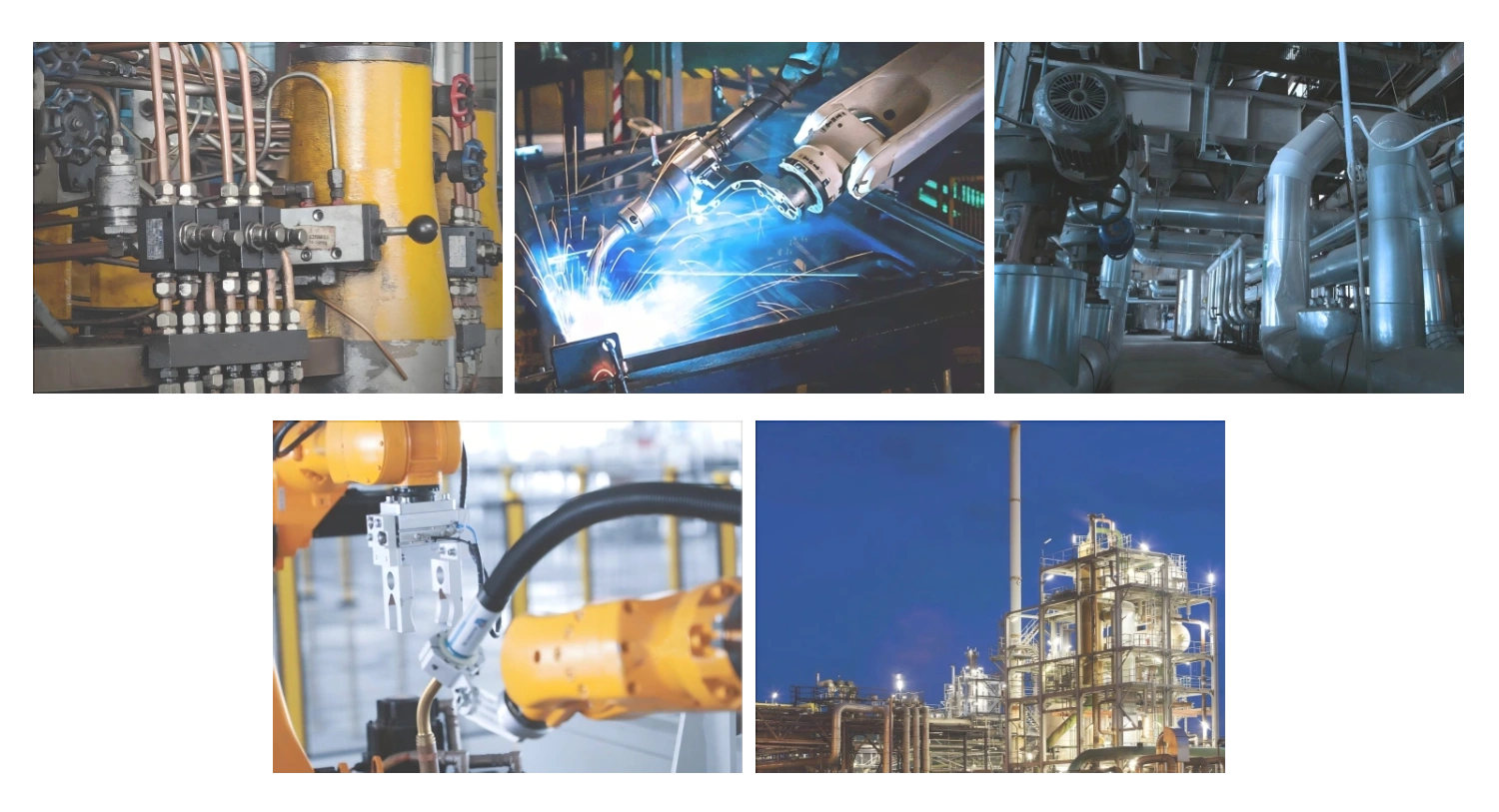Sørg for korrekt overflade- og flensforberedelse
Rengør flensoverflader grundigt: Fjern affald, rust og rester af gamle pakninger
Ifølge data fra Fluid Sealing Association fra 2022 skyldes omkring 43 % af alle utætheder i gummiafkølingssystemer i industrielle systemer, at ingen tog sig af at rengøre flangefladerne ordentligt. Første trin? Tag en kvalitets tråtbørste og skrub fladerne grundigt for at fjerne rust eller oxidation. Derefter tørrer du alt af med noget som acetone eller en anden egnet opløsningsmiddel for at fjerne olie og restprodukter fra produktionen. Spring ikke over dette trin. Skinn herefter med en lommelygte over den rengjorte flade. Undersøg nøje efter små partikler, der måtte sidde fast. Allerede partikler mindre end 0,1 mm kan føre til utætheder under drift, når trykket stiger. Det er det ekstra minut eller to værd at undgå hovedpine senere.
Vurder fladens fladhed og overfladebeværk for effektiv tætning med gummiafkøling
Når flanger ikke er perfekt flade, kan selv små afvigelser over 0,05 mm over en diameter på 150 mm forstyrre kompressionen og føre til dårlig tætningsydelse. For at tjekke, om en flange er flad nok, bruger de fleste teknikere en lige kant sammen med føleblade til præcise målinger. Overfladens finish er også vigtig, så søg efter flanger med en ruhedsgennemsnit (Ra) mellem 3,2 og 6,3 mikrometer. I situationer, hvor trykket overstiger 150 psi, giver det stor forskel at vælge spejlfinerede overflader med Ra under 1,6 mikrometer, især når de kombineres med spiralformede tætninger. Studier viser, at denne kombination reducerer mikrolekproblemer med omkring tre fjerdedele sammenlignet med standardmæssigt ruere overflader, hvilket forklarer, hvorfor mange industrielle installationer nu specifikkerer disse krav.
Undersøg flangernes retning for at forhindre ujævn kompression og utætheder
Flangeforlægning medfører skævhed i gummipakninger, hvilket fremskynder deres slid og nedslidning. For at tjekke forholdene ordentligt, skal du se på afstandsmålinger omkring de vigtige urepositioner: 12, 3, 6 og 9-tiden. ASME B31.3-koden tillader faktisk op til 1,6 mm forskydning, før det bliver et problem. Hvis flangerne er forlægget med mere end 2 mm, skal du glemme at bruge almindelige hammers til reparation. Hydrauliske jekboltter fungerer bedre her, fordi det at hamre dem tilbage ofte forværrer parallelle problemer med omkring 30 til 40 procent. At få flangeforlægningen rettet op er vigtigt, fordi det fordeler boltnormallast jævnt over alle forbindelsespunkter og opretholder korrekt tryk på pakningsmaterialet gennem hele dets levetid.
Vælg den rigtige gummipakning til driftsforholdene
Valg af den korrekte gummipakning indebærer at afstemme materialeegenskaber med temperatur, tryk og kemisk påvirkning. Afvigelser står for 43 % af pakningslækager (Ponemon 2023), hvilket gør valg af applikationsspecifikke pakninger afgørende for langsigtet pålidelighed.
Afstem pakningsmaterialet til temperatur, tryk og væskemedier
Gummipakningsydelse afhænger af termisk stabilitet og kemisk kompatibilitet. Nøglevalg inkluderer:
- Nitril (NBR) : Ideel til oliebaserede miljøer (-40°F til 212°F), men sårbar over for ozonnedbrydning.
- Silikone : Kan håndtere ekstreme temperaturer (-80°F til 450°F), hvilket gør det egnet til fødevareindustri og termisk cyklus.
- EPDM : Virker godt i damp- og vandsystemer (-50°F til 300°F), men svulmer op i petroleumsvæsker.
| Materiale | Temperaturinterval | Kemisk modstandsdygtighed | Almindelige anvendelser |
|---|---|---|---|
| Nbr | -40°F til 212°F | Olier, brændstoffer | Automobilbrændstofsystemer |
| EPDM | -50°F til 300°F | Vand, damp, svage syrer | Ventilationsrør |
| Silikone | -80°F til 450°F | FDA-godkendte opløsningsmidler | Farmaceutisk udstyr |
Vurdering af kemisk og miljømæssig modstandsevne af NBR-, EPDM- og silikongummi pakninger
EPDM's modstandsevne over for UV og vejrforhold gør det ideelt til udendørsinstallationer, mens NBR's oliebestandighed er velegnet til hydrauliske systemer. Silikon bevaret fleksibilitet under termisk stress, hvilket gør det fordelagtigt til kryogene anvendelser. Undgå standard EPDM i hydrokarbonmiljøer – risikoen for svulmning øges med 78 % (Ponemon 2023).
Undgå generisk pakningsbrug: Prioriter anvendelsesspecifik udvælgelse
Systemer, der bruger anvendelsesspecifikke pakninger, rapporterer 62 % færre lækager end dem, der anvender almindelige tætninger, hvilket fremhæver værdien af skræddersyet materialevalg. I aggressive kemiske miljøer yder fluorcarbonbaserede forbindelser bedre end standard nitrilblandinger og bør prioriteres.
Opnå præcis placering og justering af pakning
Placer gummipakningen nøjagtigt på flangens overflade for at forhindre ekstrudering
Placer pakningen inden for 1,5 mm fra flangens geometriske centrum. Forkert justering ud over denne tolerance øger risikoen for ekstrudering med 40 % i tryksystemer (Piping Systems Journal 2023). Bekræft koncentricitet ved hjælp af flangemærkninger eller laserjusteringsværktøjer, før boltespændningen påføres.
Brug justeringsværktøjer eller centreringshjælper til ensartet placering
Centreringspæle reducerer installationsfejl med 72 % sammenlignet med manuelle metoder (Fluid Sealing Quarterly 2024). For flanger med en diameter over 12 tommer skal tre vinklede justeringsklemmer bruges for at fastholde pakningens position under spænding. Disse hjælper forhindrer kantforvrængning, især i højvibrationsmiljøer som pumpe- eller dampledningsforbindelser.
Anvend korrekt boltespændingssekvens og moment
Spænd bolterne i en korsmønstersekvens for ensartet kompression
Brug en stjerne- eller korsmønster-sekvens for at fordele trykket jævnt og forhindre flangevridning. Start med manuel spænding, og følg derefter ASME PCC-1-2023 retningslinjer ved hjælp af tre momenttrin: 30 %, 70 % og 100 % af den endelige værdi. Denne metode reducerer spændingskoncentrationer med 15–22 % sammenlignet med sekventiel spænding, hvilket minimerer lokal ekstrudering.
Brug flertrinsmoment til gradvis kompression af gummietning
Trinvis spænding tager højde for elastomerhukommelse og sikrer stabil kompression:
- Første gennemgang : Anvend 30–50 % moment for at sætte tætningen
- Anden gennemgang : Øg til 70–80 % for forudgående kompression
- Sidste gennemgang : Nå fuldt moment for at opnå optimal tætningsdensitet
Gradvis kompression bevarer elastomerens integritet, især under termisk cyklus.
Kalibrer momentværktøjer for at sikre nøjagtighed og reproducerbarhed
Ukalibrerede momentværktøjer kan afvige med ±25 % fra målværdier (Plant Engineering, 2023). Ved regelmæssig kalibrering og anvendelse af digitale sensorer reduceres afvigelsen til ±3 %, hvilket sikrer en konstant klemmekraft. Ved kritiske samlinger kan momentkontroller suppleres med ultralydsmåling af boltlængdeforlængelse.
Case-studie: Reducering af utætheder i en kemisk fabrik gennem korrekt momenttrinindstilling
En kemisk fabrik i Midtvesten reducerede flenslekkage med 75 % over otte måneder ved at implementere en 4-trins momentprocedure for EPDM pakninger med 2 timers intervaller mellem trinene for at tillade spændingsafslapning. Efterimplementeringsauditter viste 92 % momentkonsistens over 1.200 flensforbindelser (Plant Engineering-rapport 2022).
Udfør efterspænding efter installation for at fastholde tætningsintegritet
Momentindsæt boltene igen efter den oprindelige systemtrykbevægelse for at kompensere for pakningsafslapning
De fleste gummipakninger har tendens til at miste omkring 10 til måske endda 15 procent af deres kompression allerede efter én dag på grund af materialesætning. Forholdene forværres, når der sker termisk cyklus eller når pakningerne udsættes for forskellige væsker, hvilket betydeligt fremskynder nedbrydningsprocessen. Ifølge nogle brugerberetninger fra Fluid Sealing Association fra 2023 kan omkring syv ud af ti flenslækker i kemiske procesanlæg faktisk føres tilbage til forkert gen-spændingspraksis. For bedste resultater bør teknikere udføre den første gen-spændingskontrol inden for ca. fire timer efter driftstart og følge nøjagtigt den samme spændingsrækkefølge, der blev brugt oprindeligt. Målet er her at fastholde momentværdierne tæt på de oprindeligt specificerede, helst ikke mere end plus eller minus 10 procent afvigelse.
Følg anbefalede gen-spændingsintervaller baseret på driftsforhold
Udstyr i områder med høj vibration kræver generelt tjek én gang om ugen, mens systemer, der står stille, kan vente cirka tre måneder, før de skal tjekkes. Når temperaturen stiger over 150 grader Fahrenheit (ca. 65 grader Celsius), bør inspektionerne finde sted cirka 30 % oftere, da varmen virkelig fremskynder nedbrydelsen af gummidele. Det er vigtigt at udføre arbejdet med at spænde møtrikker, når alt er ved stuetemperatur, fordi bolte har tendens til at løsne eller spænde ca. 1 til 2 procent for hver temperaturudsving på 18 grader. At føre protokol over alle disse drejningsmomentmålinger hjælper teknikere med at vurdere, om noget blot kræver almindelig vedligeholdelse, eller om det er tid til at udskifte pakninger helt. Mange værksteder har på den hårde måde lært, hvad der sker, hvis de glemmer at føre ordenlig dokumentation.
Typisk genopspændingsplan
| Driftstilstand | Første genopspænding | Vedholdende interval |
|---|---|---|
| Høj temperatur (>250°F) | 4 timer | Ugevis |
| Kemisk eksponering | 8 timer | Hver 14. dag |
| Lavtryksdamp | 24 timer | Månedligt |
Ofte stillede spørgsmål
Hvorfor er det vigtigt at rengøre flangefladerne, før en gummipakning monteres?
Rein ud fra flangefladerne fjerner grundigt snavs, rust og rester af gamle pakninger, som ellers kan føre til pakningsfejl og utætheder. En ren overflade sikrer korrekt pakningens vedhæftning og funktion.
Hvordan finder jeg den rigtige pakningsmateriale til min anvendelse?
Overvej den driftsmæssige temperatur, tryk og kemisk påvirkning. Pakningsmaterialer som nitril, silikone og EPDM har forskellige egenskaber, der gør dem egnet til bestemte miljøer.
Hvorfor er momentrækkefølgen vigtig ved pakningsmontering?
Ved at følge en korrekt momentrækkefølge sikres jævn kompression og forhindrer flangens krumning, som kan føre til pakningsfejl og utætheder.
Hvor ofte bør jeg genoptætte bolte efter pakningsmontering?
Genoptætningsintervaller afhænger af driftsforholdene. Udstyr i områder med høj vibration kan kræve ugentlige kontroller, mens statiske systemer måske ikke har brug for så hyppige inspektioner.
Hvilke værktøjer kan hjælpe med præcis pakningsplacering?
Justeringsværktøjer som centreringsstænger og klammer hjælper med at sikre korrekt pakningsposition, hvilket reducerer risikoen for ekstrudering og installationsfejl.
Indholdsfortegnelse
- Sørg for korrekt overflade- og flensforberedelse
- Vælg den rigtige gummipakning til driftsforholdene
- Opnå præcis placering og justering af pakning
- Anvend korrekt boltespændingssekvens og moment
- Udfør efterspænding efter installation for at fastholde tætningsintegritet
-
Ofte stillede spørgsmål
- Hvorfor er det vigtigt at rengøre flangefladerne, før en gummipakning monteres?
- Hvordan finder jeg den rigtige pakningsmateriale til min anvendelse?
- Hvorfor er momentrækkefølgen vigtig ved pakningsmontering?
- Hvor ofte bør jeg genoptætte bolte efter pakningsmontering?
- Hvilke værktøjer kan hjælpe med præcis pakningsplacering?







